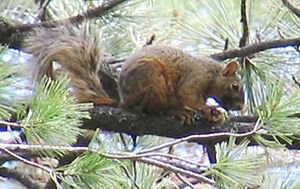Mexican fox squirrel facts for kids
Quick facts for kids Mexican fox squirrel |
|
|---|---|
 |
|
| Conservation status | |
| Scientific classification | |
| Genus: |
Sciurus
|
| Species: |
nayaritensis
|
| Subspecies | |
|
|
 |
|
| Mexican fox squirrel's range | |
The Mexican fox squirrel (Sciurus nayaritensis) is a type of tree squirrel. It lives in the forests of Mexico and a small part of the United States. You can find it in the Sierra Madre Occidental mountains in Mexico. It also lives in the Chiricahua Mountains in southeastern Arizona, USA.
This squirrel is sometimes called the Nayarit, Apache, or Chiricahua fox squirrel. Scientists say it is a "Least Concern" species. This means it is not currently in danger of disappearing.
Contents
About the Mexican Fox Squirrel
Physical Features
The Mexican fox squirrel has a brownish back. It looks "grizzled," which means it has a mix of colors. Its belly is usually yellow or reddish-orange. Its tail is dark gray with white tips, making it look "frosted."
These squirrels change their fur twice a year. Their winter fur is often more reddish. They weigh about 700 grams (about 1.5 pounds).
Daily Life and Habits
Mexican fox squirrels are active during the day. This means they are "diurnal." They do not claim specific territories. They also do not sleep through the winter, which is called "hibernating."
What They Eat
The Mexican fox squirrel spends a lot of time looking for food. They search on the ground and in tree branches. They eat tree seeds, flowers, and fungi (like mushrooms).
They are very good at getting seeds from pine cones. They pull off each part of the cone to get to the seeds. They also eat acorns and walnuts when they can find them. They enjoy other tree seeds and sometimes insects.
These squirrels sometimes hide large seeds. They bury them in leaves or the topsoil. This is called "scatterhoarding."
Predators
Not much is known about the Mexican fox squirrel's life. However, large birds of prey (like eagles), wild dogs, wild cats, raccoons, and snakes are likely their main predators.
Reproduction and Life Cycle
Mexican fox squirrels usually have one small litter of babies each year. They typically have 1 or 2 young. This usually happens in late spring or summer.
They build their nests, called "dreys," in trees. These nests are shaped like balls and made of sticks and leaves. Sometimes, especially when they have babies, they use holes inside large trees. They have been known to share nests with other squirrels.
Mexican fox squirrels are usually very quiet. If they get scared, they try to hide and stay still. If they feel safe in a tree, they might bark or make chucking sounds.
Where They Live (Habitat)
Mexican fox squirrels live in different types of forests. They can be found in lower areas, around 1,500 meters (about 4,900 feet) high. These forests have a mix of pine and oak trees. They also live in higher forests, below 2,700 meters (about 8,900 feet) high, with different kinds of conifer trees.
Areas near rivers with large cottonwood and sycamore trees often have the most squirrels. In the United States, these squirrels only live in the Chiricahua Mountains of southeastern Arizona.
These squirrels prefer forests that have had small, frequent fires in the past. These fires keep the forest floor open and allow large trees to grow.
Different Types of Mexican Fox Squirrels
There are three different types, or subspecies, of the Mexican fox squirrel:
- Sciurus nayaritensis nayaritensis (Nayarit fox squirrel): This type lives in the southern part of the squirrel's range. It is smaller and more yellowish.
- Sciurus nayaritensis apache (Apache fox squirrel): This type lives in the northern and central parts of the range. It is in between the other two in size and color.
- Sciurus nayaritensis chiricahuae (Chiricahua fox squirrel): This type lives only in the Chiricahua Mountains in Arizona, USA. It is known for being more reddish all over.
See also
 In Spanish: Ardilla zorro mexicana para niños
In Spanish: Ardilla zorro mexicana para niños


